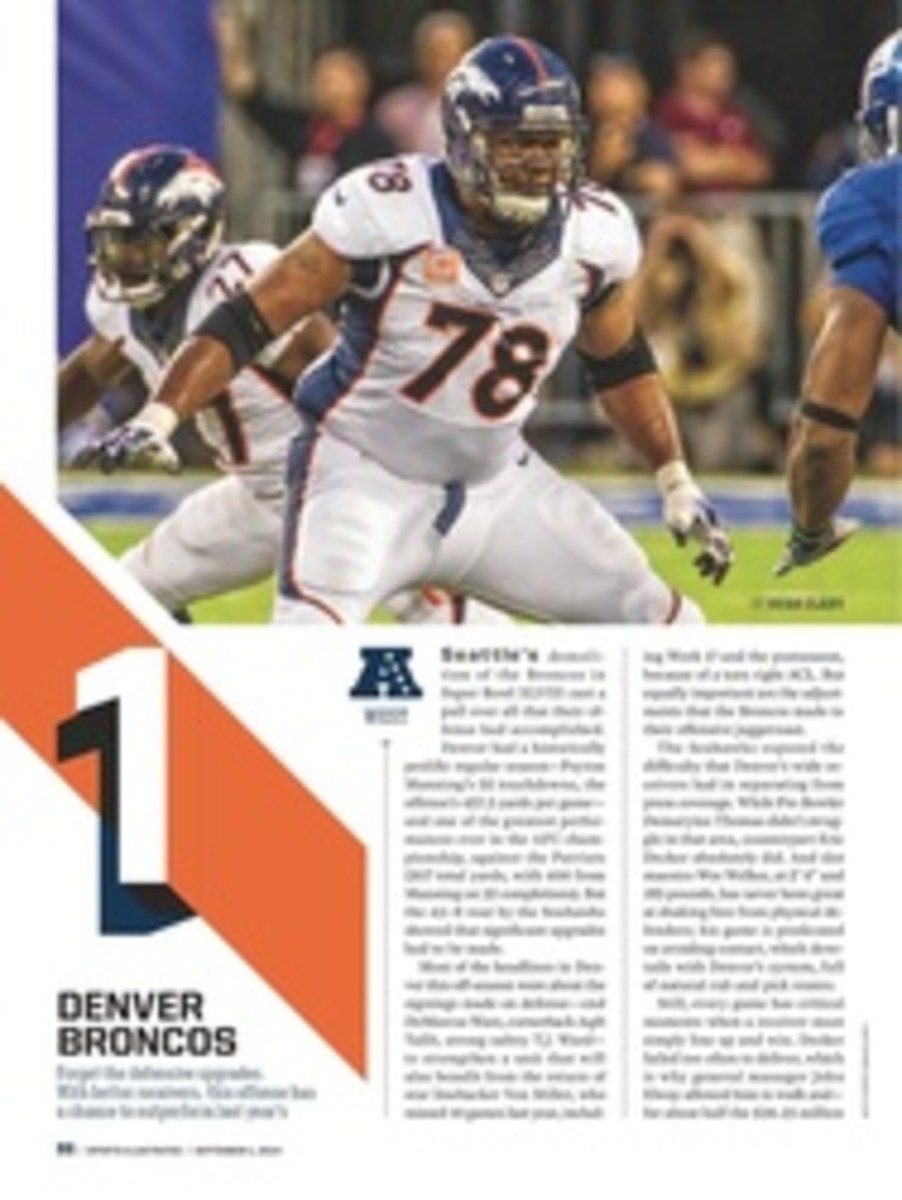
2 HOUSTON TEXANS
We hear all the time about big-play offenses. But how about big-play defenses? Typically, those are the product of high-risk, high-reward schemes like those implemented by the Saints several seasons ago under Gregg Williams or, to a lesser degree, Dom Capers's Packers.
The Texans are positioned to be a big-play defense through more ideal means: sheer star power. And that represents their best chance at getting out of the AFC South basement under new coach Bill O'Brien.
NFL fans are already familiar with one of Houston's star defenders. End J.J. Watt is not just the best D-lineman in football, he's the best defensive player. Period. Despite facing constant double teams on the strong side (that is, across from an offensive tackle and tight end), Watt has 31 sacks and 23 pass deflections over the past two seasons. His penetration and powerful readjustments in traffic have also created countless other opportunities for teammates. Prime example: Five of Watt's pass deflections the last two years have resulted in interceptions.
Hoping to nab another once-in-a-generation defensive talent, Houston used the No. 1 pick in this year's draft on Jadeveon Clowney. The outside linebacker from South Carolina does not quite possess the quick twitch and natural bend of most elite pass rushers, but his power and speed off his second and third steps can be surreal. The concerns about Clowney pertain more to his character and drive. If he can't get up for playing alongside Watt and for esteemed position coach Bill Kollar, he can't get up for anything.
Watt isn't the only one who'll be pushing Clowney. Inside linebacker Brian Cushing is a high-octane player and possesses a tremendous on-field IQ. Before missing the majority of the past two seasons with devastating left-knee injuries, he was also one of the most explosive downhill attackers in the game—something that showed not just in his run pursuit but also in his blitzing. Still only 27 and a workout warrior, he's capable of reclaiming his place among the elite at his position.
Making big plays consistently requires the support of a quality secondary. Cornerback Johnathan Joseph is capable of shadowing No. 1 receivers and has a sense for undercutting routes when the ball's in the air. At strong safety D.J. Swearinger is by no means a star; he has a tendency to miss tackles and lose poise. But the second-round pick from 2013 does bring an intriguing array of skills, including the ability—at 5'10", 208 pounds—to cover tight ends man-to-man. Swearinger was exploited early last season but showed significant improvement in November and December.
Any defense, big-play-oriented or not, can only be as good as its ability to stop long plays. And here the Texans face a few concerns. Up front, opposite Watt, they'll count on career backups Tim Jamison and Jared Crick to fill the sizable shoes of gap-shooting veteran end Antonio Smith, who signed with the Raiders. That's a downgrade in raw talent, and it's uncertain whether either replacement can maintain the tenacity he's shown in relief while playing more snaps.
Opposite Clowney at outside linebacker, Whitney Mercilus (the fourth first-round pick in coordinator Romeo Crennel's front seven) has flashed brilliance but must live up to his surname and make a greater impact down to down. Mercilus has a burst but suffers from tentativeness at times. He'll line up alongside Brooks Reed, an outside 'backer (and college defensive end) who may move to the inside, where he'll have to adapt his mechanics and diagnostics.
On the back end the Texans lack depth behind Kendrick Lewis and Chris Clemons (mundane safeties both) and corners Kareem Jackson (improved, but almost strictly a boundary player) and Brandon Harris (who can only play the slot). That means Crennel lacks the luxury of coverage flexibility that his predecessor, Wade Phillips, enjoyed.
Crennel is also unlikely to have a well-rested group; Houston's offense won't control the tempo as effectively as it has in years past. Under O'Brien the Texans have shifted away from their zone-running, play-action system, and the new Patriots-style scheme will have to operate with questions at several receiving spots as well as at quarterback. New starter Ryan Fitzpatrick is in a strong position to learn O'Brien's system, having played for four teams and started 77 games in his nine-year career. But his aggressive style of play will present more cons than pros.
With this in mind, Crennel may feel obligated to pursue big plays through schematic gambles. But if the Texans are to climb back out of the AFC South basement, a few star defenders must make magic on their own.
2014 SCHEDULE
2013 Record: 2--14
WEEK 1
WAS [HOME]
OAK [AWAY]
NYG [AWAY]
BUF [HOME]
DAL [AWAY]
IND THUR [HOME]
PIT MON [AWAY]
TEN [AWAY]
PHI [HOME]
BYE
CLE [AWAY]
CIN [HOME]
TEN [HOME]
JAX [AWAY]
IND [AWAY]
BAL [HOME]
JAX [HOME]
WEEK 17
FOCUS ON
The backfield
The man quarterbacking Bill O'Brien's new offense, Ryan Fitzpatrick, is a boom-or-bust, 31-year-old journeyman who tends to lose sense of a play's structure and who throws balls into tighter coverage than his arm strength should dictate. While those gambles sometimes pay off, they're not a good fit for a scheme built on disciplined timing and reading option routes. For stability, this attack will have to rely on Arian Foster and the ground game. Foster battled back problems last season, but he insists they were less severe than they sound. At just 28 he should regain the fluidity—uncommon for a 6'1" 227-pounder—that he has shown in the past and once again contend for the AFC rushing title. Soft-handed, he'll also play a larger role in Houston's passing game, acting as a steadying force. O'Brien will implore Fitzpatrick to lean on him.
THE CASE FOR
Receiver Andre Johnson
During the past six months the 12th-year veteran—and likely future Hall of Famer—has voiced his displeasure over Houston's retooling and history of mediocrity. But ultimately a $10 million salary for 2014 made it worth reporting for duty. And Johnson remains more than capable of playing the role of a true No. 1 target. While he may have lost the elite speed that put him in football's upper echelon, he still knows how to get open. And at his position, speed is less important than people think because a receiver can dictate the pace of play. Johnson might run a beat slower, but opponents still have to react to him. And with a knack for disguising routes and redirecting late in a pattern while tracking the ball, Johnson makes reacting difficult. That's how he was able to rack up 1,407 yards in '13, despite a carousel at QB, and 1,598 the year before that. The Texans need another big year out of Johnson because they lack depth at the position. And depending on how third-round rookie C.J. Fiedorowicz (Iowa) develops, they could be thin at tight end. The upside: Young receivers DeAndre Hopkins, Keshawn Martin and DeVier Posey can learn from one of the alltime best.
PHOTO
KIRBY LEE/USA TODAY SPORTS
OLB JADEVEON CLOWNEY
PHOTO
ED ZURGA/AP
NINTEEN PHOTOS

